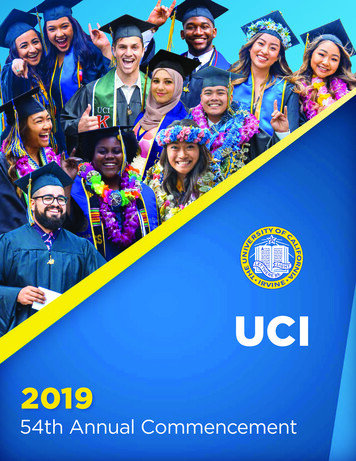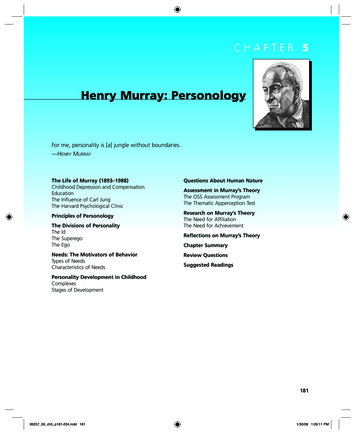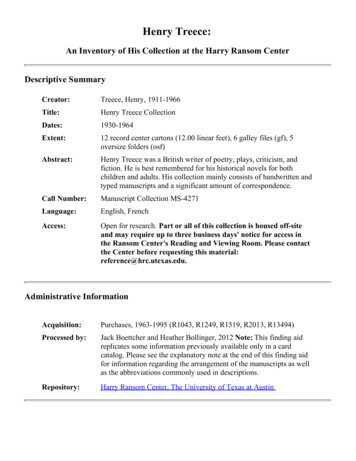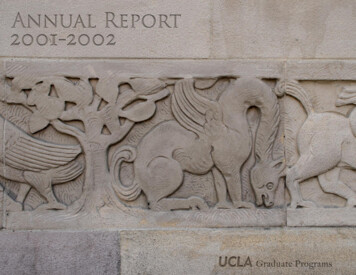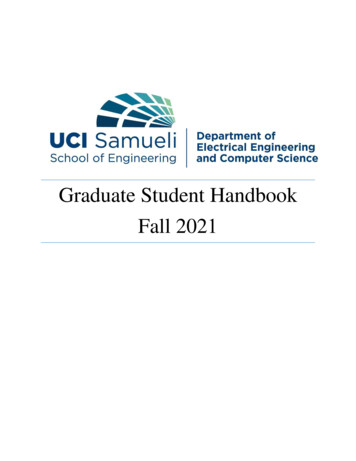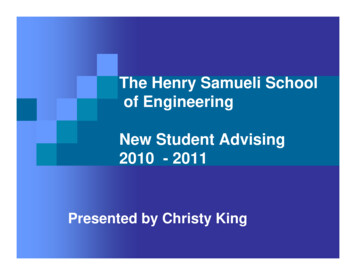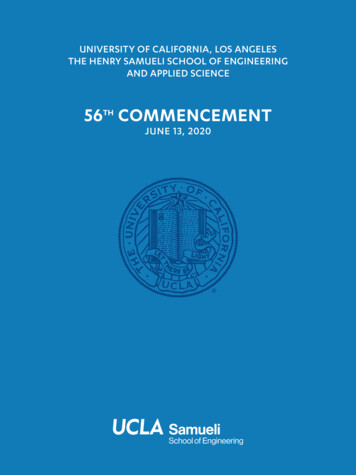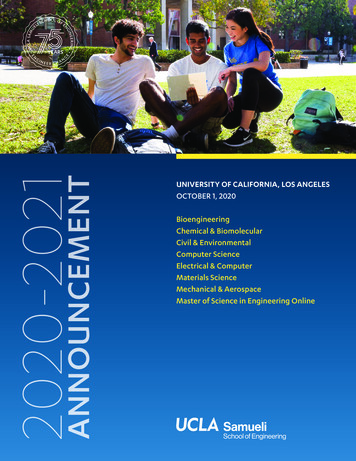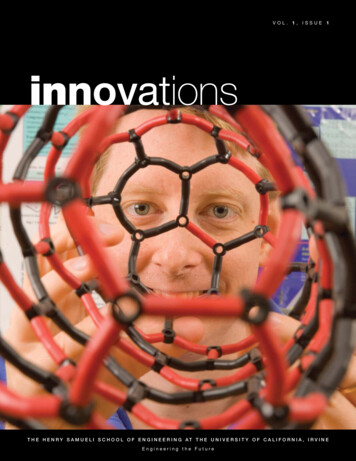
Transcription
VOL. 1, ISSUE 1innovationsT H E H E N R Y S A M U E L I S C H O O L O F E N G I N E E R I N G AT T H E U N I V E R S I T Y O F C A L I F O R N I A , I R V I N EEngineering the Future
Dean’s CornerDear Friends,Welcome to the first edition of Innovations fromThe Henry Samueli School of Engineering at UCIrvine. Many exciting developments are takingplace at our School highlighted by the growth infaculty, grants, and research expenditures, andwe are pleased to share them with you.Successes of particular note include the addition of six newfaculty members, making our School 101 strong. In 2004-05,research expenditures continued to expand, totaling 20.8million. Further, graduate student enrollments reached 684, ourlargest population to date.Earlier this year we initiated a popular new faculty lecture seriesentitled, “Engineering Innovations,” which highlights our ownfaculty members each quarter to discuss a variety of importantindustry-related topics. Lectures have included “The BionicHuman,” and “Will Carbon Replace Silicon as the TopEngineering Material?” Upcoming lectures include “EngineeringNew Materials That 'Talk' to Cells” in April, and “Visualization onMultiple Scales,” in June.As we look forward into the Spring Quarter, we are pleased toannounce our 5th annual industry research symposium“California: Prosperity Through Technology,” which will be heldMay 15-17. The theme of this year’s event is “Engineeringin Medicine.” Speakers will address the convergence ofengineering and medicine, focusing on emerging trends andissues facing the state and nation’s biomedical community.We look forward to seeing you at thesymposium. For more event information pleasevisit http://www.eng.uci.edu/cptt.Finally, this year we will embark on theconstruction of our new Engineering III buildingthat will primarily house the Department ofElectrical Engineering and Computer Science, as well as acombination of wet and dry laboratories, faculty offices andclassrooms. Designed to be a catalyst for collaboration throughwhich innovative research will be developed, our new buildingwill be in close proximity to the California Institute forTelecommunications and Information Technology (Calit2) and theDonald Bren School of Information and Computer Science’s newbuilding.Here at The Henry Samueli School of Engineering, we areextremely proud of our accomplishments and welcome yourinterest in our progress.Sincerely,Nicolaos G. AlexopoulosSpecific topics include: Engineering Science in Ophthalmology and VisionTechnologies Engineering in Neuroscience and Rehabilitation Nano/Micro Technologies for Cancer BioMEMS for Medical Implantable DevicesInnovations is published twice annually by the Office of Development and External Relations at The Henry Samueli School of Engineering at UC Irvine.
The Henry Samueli School of EngineeringDeanNicolaos G. AlexopoulosAssociate Dean for Academic AffairsWilliam E. SchmitendorfAssistant Dean, Planning & AdministrationJanice HolsteinAssociate Dean for Student AffairsJohn C. LaRueDepartment ChairsBiomedical Engineering – William C. Tang, interimChemical Engineering and Materials Science – Stanley B. GrantCivil and Environmental Engineering – Masanobu ShinozukaElectrical Engineering and Computer Science – Jean-Luc GaudiotMechanical and Aerospace Engineering – Roger H. RangelCommunicationsDirector of Communications – Lisa BriggsCommunications Specialist – Christy BoyerDesignVince Rini DesignPhotographyPaul Kennedy PhotographyCorporate Advisory Board MembersAdvanced Infrastructure Management, Inc.Advanced Medical OpticsAeA Orange County CouncilThe Aerospace CorporationApplied Wave Research, Inc.Phil BeaudoinBen Du FoundationBoeing Phantom WorksBroadcom CorporationConexant Systems, Inc.Connexion by BoeingDartbrook Partners, LLCDomain Associates, LLCEdwards LifesciencesEmulex CorporationFord Motor CompanyHitachi Chemical Research Center, Inc.Irvine SensorsKnobbe, Martens, Olson & Bear, LLPThe Massiah FoundationMicrosoft CorporationMindspeed Technologies, Inc.MSC SoftwareNewport CorporationNexgenix Inc.NS HoldingsNicholas EnterprisesNorthrop Grumman CorporationNorthrop Grumman Space TechnologyParker Hannifin CorporationPowerwave TechnologiesPrintronixSkyworks Solutions, Inc.Stradling Yocca Carlson & RauthUnisys Corp.Versant VenturesWestern Digital CorporationnnovationsDevelopment and External RelationsDirector of Development – Jamie Stewart MarshAssistant Director of Development – Melissa CoheaTable of ContentsCALENDAR2ENGINEERING NEWS3RESEARCH8FA C U LT tions 1
Calendar :MARCHJUNEMighty Ducks Hockey GameEngineering Alumni Council ActivityMar. 5, 1 p.m.Visualization on Multiple Scales: From Small to LargeEngineering Innovations Lecture Series IVFeaturing Falko Kuester & Joerg Meyer,University of California, IrvineJune 20, 7:45-9 a.m.Top Five Data Challenges for the Next DecadeDean’s Distinguished Lecturer SeriesFeaturing Patricia Selinger, IBMMar. 13, 6-7 p.m.Reception to followNon-invasive Assessment of Cardiovascular Control in SleepApnea: Basic and Translational Research StudiesBME Distinguished Lecturer SeriesFeaturing Michael Khoo, University of Southern CaliforniaMar. 16, noon-1 p.m.CELEBRATE UCIAPRILSaturday, Apr. 22 from 9 a.m. to 5 p.m.Engineering New Materials That 'Talk' to CellsEngineering Innovations Lecture Series IIIFeaturing Andrew Putnam, University of California, IrvineApr. 4, 7:45-9 a.m.Control of Cell and Tissue Function via Protein BiomaterialsBME Distinguished Lecturer SeriesFeaturing David Kaplan, Tufts UniversityApr. 20, noon-1 p.m.MAYDigital Humans: From Biomechanical Models to SimulatedSurgeryBME Distinguished Lecturer SeriesFeaturing Scott Delp, Stanford UniversityMay 4, noon-1 p.m.California Prosperity Through Technology2006 Industry Research SymposiumTheme: Engineering in Medicine and LifeChip TechnologiesCo-sponsored by UC Irvine’s School of MedicineMay 15-17Structurally and Functionally Integrated Computational Biologyof the HeartBME Distinguished Lecturer SeriesFeaturing Andrew McCulloch, University of California, San DiegoMay 18, noon-1 p.m.2 innovationswww.eng.uci.eduCome to UCI’s 28th annual Open House, one of thecampus’ oldest and most festive traditions. This spring eventfeatures games and rides for children, an Earth Day celebration,academic information, classic car show, campus tram tours,Wayzgoose Medieval Faire with food booths, demonstrations,rides, games, and much more. You are all invited! It’s anexcellent opportunity to bring family and friends to visit and seewhat’s new with our campus. Join the alumni, staff, faculty,and students as we Celebrate UCI! Events and parking areFREE. For more information, call UCI at (949) 824-5182 or visitour website at www.uci.edu/celebrate.
Engineering News :California: Prosperity Through TechnologySymposium Garners More Than 300 AttendeesIndustry-leading experts and top faculty researchers tackled focus topics:energy, aerospace, biomedical engineering and communications technologyPhotos: Students present research findings at poster session (above), Scott McGregor, CEO, Broadcom (above right)The Henry Samueli School of Engineering at UC Irvinehosted its fourth annual “California: Prosperity ThroughTechnology” industry research symposium, May 23 and 24,2005. More than 300 people attended the unique event,developed to create a professional platform for industryleaders and academic visionaries to address significanttechnological trends and new ideas shaping the state andcountry.James V. Mazzo, CEO, Advanced Medical Optics“Advanced Medical Optics: An Ophthalmic Medical DeviceLeader”The two-day symposium was held at the Arnold and MabelBeckman Center of the National Academies, in Irvine, Calif., andwas supported by 37 sponsors from leading companies acrossthe industry.David Whelan, Vice President, Boeing“Emerging Technologies: Driving Boeing’s Growth”Key executives gathered together with academic experts in avariety of specialized fields to present, discuss and debatecrucial areas of technological convergence, vital to the continualand future prosperity of California and the nation. Focus topicsincluded energy, aerospace, biomedical engineering andcommunications technology.Diverse presentations and panels ranged from new frontiers inaerospace engineering and pervasive communications, to adynamic panel discussing ways in which American companiescan stay competitive in a global economy. Sessions included:C. I. “Jim” Chang, Ph.D., Deputy Director for Basic Scienceand Director, Army Research Laboratory“Innovations vs. Multidiscipline Technology – Objectives forFundamental Understanding and Economic Competitiveness”Scott A. McGregor, President and CEO, Broadcom Corp.“Connecting Everything, Converging Everything”Christina Carlisle Jones, CEO, Extend Fertility“Challenges and Opportunities Facing Today’s Entrepreneur”Vinay Gokhale, Vice President, Impinj Inc.“RFID Technology: Challenges and Opportunities”Raouf Y. Halim, CEO, Mindspeed Technologies, Inc.“Convergence Trends in Communications: Implications forCPCC and Southern California”Continuedwww.eng.uci.eduinnovations 3
Eric J. Amis, Division Chief, Polymers Division,National Institute of Standards and Technology“Disruptive Technologies: The Revolutionary Roles Played byMaterials”Albert F. Myers, Corporate Vice President,Northrop Grumman Corp.“Evolution of Transformation”Bob Kleist, President and CEO, Printronix“RFID Enables the Next Generation Supply Chain Management”James E. Press, President and COO, Toyota Motor Sales“Cars and California: Driving Progress for the Future”Dr. Henry T. Nicholas III accepts award from Dean Alexopoulos“The speakers were engaging, while discussing a broad rangeof innovative ideas” said Nicolaos G. Alexopoulos, Dean ofThe Henry Samueli School of Engineering. “They createddynamic synergy and contagious enthusiasm for thedevelopment of future technologies.”Attendees also had the unique opportunity to hear from manyprominent keynote speakers during symposium events includingindividuals such as Scott A. McGregor, President and CEOof Broadcom Corp., Christina Carlisle Jones, Founder andCEO of Extend Fertility, and C. I. “Jim” Chang, Ph.D., deputydirector for Basic Science and Director of the Army ResearchLaboratory.McGregor spoke to attendees about the importance ofconnecting and converging new technologies, while CarlisleJones discussed her business ventures, sharing theentrepreneurial spirit and talking about the challenges andvast opportunities facing entrepreneurs today.Chang spoke about his experiences and talked of militaryinnovations and current research projects, while also focusing onthe significance of economic competitiveness.Henry Nicholas Honored with“Engineering the Future Award”Dr. Henry T. Nicholas, III, Co-founder and former CEO ofBroadcom Corp., was presented with the prestigious“Engineering the Future Award” at the School’s annual awardsbanquet held during the California: Prosperity ThroughTechnology Symposium.Dr. Nicholas was honored for his pioneering efforts inpervasive communications, and his visionary contributions tothe advancement of engineering science and leadership in thehigh tech industry.“I was particularly pleased to present this distinguished awardto an exceptional individual who has significantly contributedto excellence in technology, here in Orange County andbeyond,” added Alexopoulos.For more information about the School’s annual symposium,and to watch videos from the event, please visithttp://ucitech05.eng.uci.edu.Save the DateMay 15-17, 2006California: Prosperity Through Technology2006 Industry Research SymposiumTheme: Engineering in Medicine and LifeChip TechnologiesDr. Jim Chang, Army Research Laboratory4 innovationswww.eng.uci.eduCo-sponsored by UCI’s School of Medicine
The bench is a symbol ofrespect and appreciationfor Pujol, the GeneralitatdeCatalunya(theCatalonian government),Balsells, and UC Irvine.The Balsells Fellowshipstudents held their ownfundraiser in honor of theoccasion to raise moneyfor the park bench.Balsells Fellowship StudentsCommemorate Program’s10th Anniversary with ParkBench DedicationUC Irvine’s Balsells Fellowship engineering students welcomedformer Catalan President, Jordi Pujol, along with honored guestand founder of the program, Peter J. Balsells, for a specialluncheon and park bench dedication ceremony in Aldrich Park,followed by a student poster session and reception at Calit2.Established in 1995, The BalsellsFellowship is an internationalacademic program created toassisttalentedengineeringstudents from Catalonia, Spain,who are seeking their postgraduate or post-doctoral degreesin engineering. Roger Rangel,Ph.D., professor and chair ofthe Mechanical and AerospaceEngineering Department, is the UCIrvine Balsell’s fellowship director,and has been consistently working with the fellows and theCatalonian government to ensure the success and future growthof the program.A crowd of students, faculty and staff gathered to witness Pujoland his bench ribbon-cutting ceremony in the park, followed bythe Balsells students dressed in bright orange shirts, building a“human tower,” to lively music, a Catalonian tradition.Later that afternoon, the Samueli School hosted a studentposter session and reception in Calit2, allowing Pujol, Balsells,and other honored guests to view student projects and askquestions. UC Irvine’s Chancellor, Dr. Michael Drake, attendedthe reception and gave a warm welcome speech to Pujol,Balsells, and the Catalonian students.On Aug. 4, the Balsells students placed an engraved park benchin Aldrich Park in honor of the program’s 10th anniversary; andPujol, who has been an influential individual in helping developthe strong sister-state relationship between Catalonia andCalifornia.Chancellor Drake and Dean AlexopoulosCongressional BriefingOn Oct. 3, The Henry Samueli School of Engineering andAdvanced Medical Optics, Inc. hosted a briefing forCongresswoman Loretta Sanchez to promote awarenessabout the alliance between the Biomedical Engineeringdepartment, the School of Medicine, and the region’swealth of biomedical device and technology companies.Chancellor Michael Drake welcomed the Congresswomanand panelists, including Jim Mazzo, CEO of AdvancedMedical Optics, Inc., Mike Mussallem, CEO of EdwardsLifesciences, David Pyott, President and CEO of Allergan,Bill Link, Co-founder of Versant Ventures, and Andy Corley,Chairman President and CEO of Eyeonics.Dean Alexopoulos, Andy Corley, Mike Mussallem, Loretta Sanchez,Jim Mazzo, Chancellor Drake, David Pyott, and Dean Cesariowww.eng.uci.eduinnovations 5
UC Irvine Hosts Receptionfor IEEE Sensors ConferenceUS News & World Reporthas ranked UCI’s engineeringschool 40th in the nationamong public and privateuniversitiesHispanic Business magazinehas ranked the SamueliSchool’s graduate program10th in the nation for Hispanicsin the September 2005 issueSurfboards, beach balls and barbeque awaited more than 500guests at UC Irvine’s reception for attendees of the Institute ofElectrical and Electronic Engineers (IEEE) 2005 SensorsConference.In addition to an “Orange County” theme, conference attendeeshad the unique opportunity to participate in technologydemonstrations held in UCI’s National Fuel Cell Research Center(NFCRC), where they had the chance to test drive GM’sHydroGen3, a hydrogen fuel-cell vehicle, and participate in avariety of demos in California Institute for Telecommunicationand Information Technology (Calit2). In addition, visitors wereable to view more than 50 posters describing many of theleading-edge technologies designed in the IntegratedNanosystems Research Facility (INRF).This is the first time the annual conference has taken place inCalifornia, due in part to UCI’s Andrei Shkel, associate professorof mechanical and aerospace engineering, who served as theGeneral Chair for the conference. The conference attractedparticipants from around the world, representing more than 40countries.6 innovationswww.eng.uci.eduOrange County Infrastructure Improving, ThoughNot Acceptable, New Report FindsAnnual investment of 4.8B necessary to improve countyinfrastructure over next 10 years. UC Irvine’s Civil andEnvironmental Engineering Affiliates, in partnership withthe Orange County branch of the American Society ofCivil Engineers, has released its 2005 Orange CountyInfrastructure Report Card, assigning a cumulative gradeof “C ” for the county’s infrastructure. The grade reflectsa slight increase since the county was assessed in 2002.
UCI Researchers ReceiveFunding for Newport BayPollution Field StudyStanley B. Grant, professor and chair of the ChemicalEngineering and Materials Science Department, Sunny C. Jiang,professor and acting chair of Environmental Health, Science andPolicy in the School of Social Ecology, and Brett F. Sanders,professor of Civil and Environmental Engineering, received an 800,000 grant from the County of Orange and the Santa AnaRegional Water Quality Control Board to study the relativeinfluence of anthropogenic and natural processes on fecalpollution in Newport Bay, the second largest embayment inSouthern California. Findings from this study will better enablecoastal zone managers to reduce the frequency of beach andshellfish harvesting closures in Newport Bay.Australian-based ResearchersPerform Real-time Cell Surgeryin California Via NewRoboLase TechnologySuccessful laser surgery and “optical trapping” was performed ina Southern California laboratory via the Internet by scientists inAustralia, using a new Internet-based laser scissor-and-tweezerstechnology called RoboLase. This laser, which was developedby a team of researchers led by Michael Berns, professor ofbiomedical engineering at UC Irvine and adjunct professor ofbioengineering at UC San Diego, demonstrates the potentialtechnology for real-time research activities between laboratories,and for physicians to perform medical procedures from remotelocations.In a proof-of-principle series of experiments, scientists from UCI,UCSD and the University of Queensland utilized RoboLase toproduce surgical holes in a distinct pattern of less than onemicron in diameter (1/1000th of a millimeter) in single cells. Byusing a control panel projected onto a computer screen,Queensland researchers were able to remotely perform the cellsurgery on a laser microscope system in the Southern Californialaboratory.www.eng.uci.eduinnovations 7
Research :Scientists Use Nanotechnology to CreateWorld’s Fastest Method for TransmittingInformation in Cell Phones and ComputersDemonstrating breakneck signal speed of 10 GHz, method uses nanotubes instead ofconventional copper wiresBY LISA BRIGGS“From now on, any time a nanotube device is used anywhere inthe world in a high-speed electronic device, computer, wirelessnetwork or telephone system, people will benefit from thistechnology,” Burke added.A nanotube is commonly made from carbon and consists of agraphite sheet seamlessly wrapped into a cylinder only a fewnanometers wide. A nanometer is one billionth of a meter, aboutthe size of 10 atoms strung together.Most of the layers of a modern semiconductor chip arededicated to interconnect wiring, making the material used, andits speed, extremely important. The semiconductor industryrecently shifted from using aluminum to copper as interconnectsbecause copper carries electrical signals faster than aluminum.Based on Burke’s work, it is now clear that changing theindustry from copper to nanotubes would provide an evenlarger performance advantage in terms of speed. Before such ashift could occur, however, nanotube technology would need tobe economical to manufacture and require precise assembly, aproject Burke is currently working on.For the first time, scientists have demonstrated that carbonnanotubes can route electrical signals on a chip faster thantraditional copper or aluminum wires, at speeds of up to 10GHz. The breakthrough could lead to faster and moreefficient computers, and improved wireless network andcellular phone systems, adding to the growing enthusiasmabout nanotechnology’s revolutionary potential.“Our prior research showed that nanotube transistors canoperate at extremely high frequencies, but the connectionsbetween the transistors were made out of somewhat slowercopper, thus forming a bottleneck for the electrical signals,” saidPeter Burke, assistant professor of electrical engineering andcomputer science, one of the researchers who developed thetechnology. “In this technology we show that nanotubes can alsoquickly route electronic signals from one transistor to another,thus removing the bottleneck.”Electrical signals are routed at high speed through virtually allmodern electronic systems and also through the airwaves in allmodern wireless systems.8 innovationswww.eng.uci.eduPrevious work by the Burke team demonstrated that nanotubescan carry electrical signals up to several millimeters across a chipbetter than copper, but did not measure how fast the signalspropagate. This work is the first interconnect-technologydemonstration for ultra-high-speed applications. Now thatBurke’s team has developed both high-speed nanotubeinterconnect technology and high-speed nanotube-transistortechnology, they hope to integrate the two into an ultrahigh-speed all-nanotube electronic circuit, faster than anyexisting semiconductor technology.Burke conducted the research along with graduate student Zhen(Jenny) Yu. The findings have been reported in the June 2005issue of Nano Letters, a peer-reviewed journal of the AmericanChemical Society, the world’s largest scientific society.The Army Research Office, the Office of Naval Research, theDefense Advanced Research Projects Agency and the NationalScience Foundation provided funding for the research, whichtook place at UCI’s Integrated Nanosystems Research Facility inThe Henry Samueli School of Engineering.
New Microfluidic Device for Nerve CellsMay Aid Efforts for NeurodegenerativeDisorders, Spinal Cord InjuriesStudy enables imaging inside living neuronsBY CHRISTY BOYERJeon, assistant professor of biomedical engineering in The HenrySamueli School of Engineering. “Our microfluidic culture platformconsists of a molded elastomeric polymer piece placed againsta glass cover slip. The design incorporates a physical barrierwith embedded microgrooves separating two mirror imagecompartments. Additionally, this method allows us to use 100times less liquid, therefore reducing costs.”By developing a device with separate micro-compartments andcreating small tunnels to connect the ‘rooms’ of thecompartments, Jeon and his team were able to study neurondamage by subjecting axons to different treatments andapplications without compromising the entire cell body.“Microfluidics is becoming an increasingly useful tool for cellularbiologists because it allows us to precisely control, monitor andmanipulate cellular environments,” Jeon added. “Through theuse of microfluidic chambers, we are able to isolate and directthe growth of axons without the use of neurotrophins, providinga highly adaptable system to model many aspects ofneurodegeneration and injury.”A new, easily manufactured microfluidic chamber will allowscientists to examine axons in living nerve cells and maylead to a better understanding of neurodegenerativedisorders such as Alzheimer’s disease and may be used toscreen drugs to overcome spinal cord injuries.Jeon and his team have applied for a U.S. patent and arecurrently negotiating a licensing agreement for manufacturingand distribution. They expect that the device will becomecommercially available by 2007.Findings are highlighted in the August 2005 edition of NatureMethods magazine.Biomedical engineer Noo Li Jeon and colleagues have designeda microfluidic device, which uses tiny volumes of fluid to culture,or grow, neurons. The technology enables live imaging ofneurons by fluidically isolating axons from other complex parts ofthe cell. This method allows researchers to examine andmanipulate the axons for their deficiencies in signal propagation,while looking at how they affect particular brain diseases anddisorders.Axons are the threadlike neuron fibers that send information vianerve impulses and other signals throughout the central nervoussystem.“Previous solutions were extremely challenging to fabricate andassemble, precluding high-throughput experimentation,” saidNoo Li Jeonwww.eng.uci.eduinnovations 9
UCI Researchers Complete World’sHighest-Resolution Display WallB Y A N N A LY N N S P I T Z E R , C a l i t 2 @ U C I S E N I O R W R I T E RScientists at UC Irvine have completed the world’shighest-resolution grid-based display for visualizing andmanipulating massive data sets. The Highly InteractiveParallelized Display Wall (HIPerWall) is a room-sized displaythat measures nearly 23 x 9 feet.The HIPerWall system, consisting of 50 flat-panel tiles, resides inthe Calit2 Center of GRAVITY (Graphics, Visualization andImaging Technology) at UCI, and provides a total resolution of200 million pixels, bringing to life terabyte-sized data sets.HIPerWall’s resolution is nearly twice that of the world’s nexthighest resolution display wall.“The resolution of state-of-the-art high-definition television isequal to one-half of one HIPerWall tile,” said Falko Kuester,assistant professor of electrical engineering and computerscience, and one of the system’s designers.“National labs are performing fluid and thermodynamicscalculations for meshes containing 27 billion cells, airborneimaging systems are delivering GIS data at centimeter resolution,and biomedical scanning devices are at the verge of generatingmulti-dimensional, time-varying high resolution images.HIPerWall’s resolution enables scientists to see complete datasets that previously could only be viewed one slice at a time.”10 i n n o v a t i o n swww.eng.uci.eduHIPerWall will be used to bring alive a variety of research data –from biomedical to climate datasets, and from numerical data tomedical imaging to satellite photography. It will be utilized by awide range of multi-disciplinary researchers at UCI, includingthose in physics, structural engineering, and theoretical andexperimental biomedical engineering.In addition, the system, which utilizes unique middleware totransport the data, will allow researchers in geographicallydiverse locations to collaborate on complex experiments.Primary among HIPerWall’s initial users will be scientists from UCIrvine’s Earth system science department, who will comparedozens of future climate simulations developed for the upcomingUnited Nations climate assessment. “Progress on fundamentalEarth System Science questions of weather, climate and theplanet's future depends on distilling meaningful insights from thelargest structured datasets ever created,” said Charlie Zender,associate professor of Earth system science.“Simultaneously exploring all the future climate scenarios givesclimate researchers working with HIPerWall a superior vantagepoint to assess and plan for Earth’s future climate.”HIPerWall allows researchers two ways to view their data: as asingle full-screen visual at a resolution of 200 megapixels; or intiled mode, as a series of smaller pictures from data streams or3D models that are displayed simultaneously for comparisonpurposes.
The project was funded with a 393,533 National ScienceFoundation grant. Development of HIPerWall data distributionand visualization middleware began in the summer of 2004 andwas followed by progressive development of the display systemfrom a single tile prototype to 2x1, 2x2, 3x3, 4x4 and finally, totoday’s 10x5 configuration of LCD panels. Each panel, with aresolution of 2560 x 1600 pixels (4 megapixels), is powered by adual-processor 2.7GHz G5 node, with nVIDIA 6800 Ultra DDLgraphics, that has access to an initial storage capacity of 10terabytes.“HIPerWall provides a unique opportunity for interdisciplinaryresearch teams to jointly visualize and analyze complexscientific data and to correlate information while drawing from abroad range of domain expertise,” said Kuester.The system’s visualization cluster is an essential component,providing unmatched data handling and distributed visualizationcapabilities. Controlled by a cluster of 25 networked visualizationservers with interconnected high-end graphics cards, HIPerWallwill allow researchers to see concurrently both the broad viewand the fine details of the data.“Each development step opened new research challenges thatguided the development of the current system,” said Kuester.“This system will now serve as the foundation for fundamentalcomputer engineering and computer science research insynergy with domain-specific research in areas such as earthsystem sciences, biomedical engineering and astrophysics.”The resolution of state-of-the-arthigh-definition television is equal“HIPerWall’s immense size and capability present significantchallenges in moving data to and from the visualization clusterand between the individual machines that comprise it. We will beworking with multi-gigabyte datasets, some of which we plan tostream from UCI’s Earth System Modeling Facility supercomputer,” said Stephen Jenks, assistant professor of electricalengineering and computer science, and another of the system’sdesigners.to one-half of one HIPerWall tile.www.eng.uci.edui n n o v a t i o n s 11
Faculty :Samueli School New HiresBIOMEDICAL ENGINEERINGFrithjof Kruggel, ProfessorKruggel’s research focuses on understanding the relation between structures and functions of the human brain.He is developing and applying new signal and image processing algorithms to the data analysis of neurofunctional methods (anatomical and functional MRI, emission tomography, event-related fields and potentials).His current work involves the quantification of neuroanatomical structures and the detection of neurofunctionalareas from high-resolution anatomical MRI datasets.Kru
Visualization on Multiple Scales: From Small to Large Engineering Innovations Lecture Series IV Featuring Falko Kuester & Joerg Meyer, University of California, Irvine June 20, 7:45-9 a.m. Calendar : 2 innovations www.eng.uci.edu CELEBRATE UCI Saturday, Apr. 22 from 9 a.m. to 5 p.m. Come to UCI's 28th annual Open House, one of the
